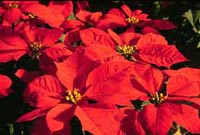Resource Library
Plant of the Week: Poinsettia
The University of Arkansas System Division of Agriculture does not promote, support or recommend plants featured in "Plant of the Week." Please consult your local Extension office for plants suitable for your region.
Plant of the Week
Poinsettia
Latin: Euphorbia pulcherrima

Walk into any business selling groceries, discount merchandise, hardware, home supplies, or plants, and you have to be careful not to trip over all of the poinsettias.
This tropical flower in the spurge family is native to Mexico and has become the symbol of Christmas the world over. Like many of our common plants, it is largely an invention of the 20th Century even though it was first introduced to the United States in 1829.
The History Behind the Name
The poinsettia carries the common name of the person introducing it to the U.S., the first ambassador to Mexico, Joel R. Poinsett (1779-1851) from Charleston, S.C. Poinsett was an important figure in American history prior to the Civil War, serving not only as ambassador, but also as senator for South Carolina and Secretary of War during the Van Buren administration. As Secretary of War, between 1837 to 1841, Poinsett saw troops under his command involved in fighting Seminole Indians in Georgia and Florida and moving the Cherokees remaining in the East to Oklahoma Territory, a process which had begun a decade earlier. Poinsett County Arkansas, established in 1838, is named after Joel Poinsett.
As senator, Poinsett led a group of politicians and founded an organization known as the "National Institute for the Promotion of Science." The group promoted the use of a 100,000-pound sterling bequest from Englishman James Smithson to develop a national museum for the relics, both industrial and natural, of the new country. This group eventually led to the establishment in 1846 of the Smithsonian Institution.
The adoption of the common name "poinsettia" is due to a botanical tug-of-war that occurred between 19th Century botanists as they struggled to classify and name the plants that were coming to them from throughout the world. Robert Graham (1786-1845), a botanist in Edinburgh, Scotland, classified the plant as a new species and called it Poinsettia pulcherrima, with the new generic name honoring Poinsett and the species name translating from Latin as "very handsome" in reference to the flowers.
This name was accepted by our leading botanical figure of the time, Harvard’s Asa Gray who was a friend of Graham. Meanwhile, in Berlin J. F. Klotzsch, the Curator of the Royal Herbarium, was studying the collection of an earlier German botanist, Karl Willdenow (1765-1812), who had tentatively classified the plant as a member of the genus Euphorbia.
Eventually, the botanists all agreed that Klotzsch was right, but by this time the name poinsettia had become entrenched as the common name for the flower.
The Floral Symbol of Christmas
After the Civil War, the poinsettia began to appear sporadically in East Coast greenhouses around the Christmas season. It was not until the turn of the century, when the Ecke family in California began growing poinsettias as a cut flower, that it really took off and became the floral symbol of Christmas. Today, the poinsettia is the largest single floricultural crop, with approximately 35 million pots sold each season.
Caring for Your Poinsettia Plant
The popularity of the modern poinsettia is due -- in part -- to its almost complete indestructibility. It should have as much light in the home as possible and be kept moist, but never standing in water. Allowing the plant to dry out will cause the leaves to drop. The ideal room temperature to maintain the luster of your poinsettia plant is 65 to 70 degrees Fahrenheit.
Even given minimal care, it should be an easy chore to keep the plant looking good until you tire of its presence on your coffee table in January. While the poinsettia is not poisonous, all plants should be kept out of the reach of toddlers that might want to go grazing on your holiday flowers.
By: Gerald Klingaman, retired
Extension Horticulturist - Ornamentals
Extension News - December 18, 1998
The University of Arkansas System Division of Agriculture does not maintain lists of retail outlets where these plants can be purchased. Please check your local nursery or other retail outlets to ask about the availability of these plants for your growing area.